

Posted: June 24, 2016 Read time: 10 Minutes
A journalist & petrolhead view of advanced driver training.
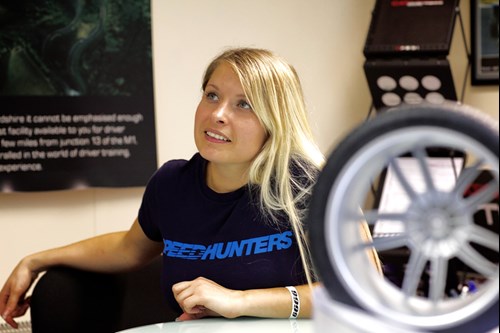
The act of learning is a never-ending process. Yet there are some areas in which we assume that what we’ve learnt already is enough. Some of these areas can even extend to potentially lethal activities that we undertake every day. But most people would never think of driving in that way. As dangerous as normal roads can potentially be, driving a performance car on track is even more fraught with peril, so wouldn’t you want to try out some of the techniques in a safe environment before you head trackside?
It’s all too easy to think of driving as just three pedals and steering. In a nutshell, that’s what things boil down to, but there are so many nuances to not only your physical actions, but also the state that the car is in and the effect that they can have, that there are many things to learn. It’s a dynamic, fluid system. Four small contact patches of tyre tread on tarmac are all that connects you and your vehicle to the road, yet there are many small changes to both the driver’s inputs and the car that can affect the overall picture, both for the good and the bad. Few are born with the skill to maximise a car’s potential - most learn it through practice.
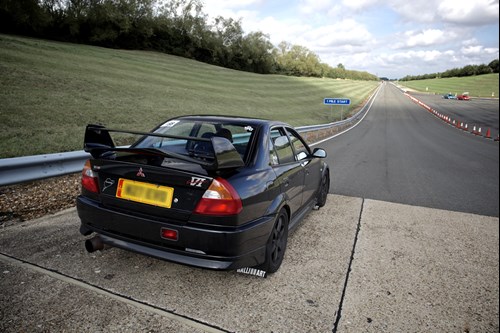
This is where CAT Driver Training come into play. With fully qualified instructors who have extensive backgrounds both in motorsports and teaching others, you know you’re in good hands. Colin, the Chief Instructor, has a background of working for Rolls Royce, a Porsche specialist and Nissan, including testing on the legendary Nürburgring. Having been in a car piloted by him on the Nordschleife, I can confirm there’s no doubting his driving abilities! I’m booked in for the day in my own car, a Mitsubishi Evo VI - there are cars that you can borrow during your time but my interests lie in getting familiar with my own car’s limitations. And of course, my own!

The lessons start off as all good lessons do - in the classroom! Before heading off on track in your pride and joy, a number of key principles are introduced which underlie pretty much every activity you’ll do throughout the day. The first is of minimising driver input. It’s no coincidence that when you see a professional racing driver, they make it look easy. The less input the driver has, the more work the car can do. There are some basic ways of putting this into practice on the track, including straight-line braking and single input steering: where the driver uses one angle of steering to complete an entire corner, moving from the entry, to clipping point and out to the exit.
Others include the importance of a good seating position, staying relaxed at the controls, responding quickly on both the wheel and the pedals (something referred to as ‘fast hands, fast feet’) and always trying to think about the weight transfer that is going on with the car and how it will be affected by your actions.
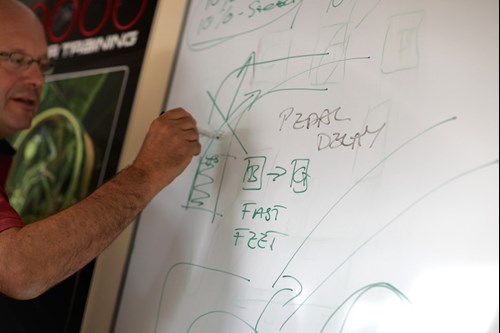
Critical to going fast is the skill of stopping. It may seem counter-intuitive at first, till you realise that the quicker you can stop, the more time you can spend at the opposite end of the spectrum: going fast. Modern brake set-ups are a far cry from older systems, but do you really know how to make the most of them?

While you might ease on and off the brakes on the road, it’s a different matter on track. The only braking that has any place there is full-on, maximum braking. This should be achieved right from the first touch of the pedal. The harder you can brake, the shorter the distance you will travel while braking, therefore giving you more time to keep on the throttle. This makes it one of the major areas to save time during a lap. But with the high capability of modern braking systems, the issue becomes achieving maximum braking without the ABS kicking in. As soon as it does, the rapid pulsing of the brakes means that the overall braking distance increases. The technique of achieving the minimum braking distance without the ABS kicking in is known as threshold braking.
At Millbrook, the mile straight provides the perfect location to practise any braking skills. With an entire mile of dead-straight tarmac to not only allow you to get up to speed, but to practice - and sometimes get wrong - the lessons you’ve just learnt. Things start off slowly, from 40mph - the first stabs at the brake pedal are accompanied by Colin questioning if you can brake any harder, and next time round, yes, it seems you can. Too hard though and the ABS starts to kick in, so you now have a limit to gauge things by.

Then the speed increases. With every 20/30mph jump, it becomes increasingly hard to get the ABS to kick in to start with. But as the car’s speed lowers, again comes the familiar locking-up sensation. At this point, Colin jumps in and advises that the speed dips, you should roll your toes up off the pedal. This lessens the pressure just enough to prevent the ABS jumping in but still keeps the maximum brake pressure. The session is rounded out with a number of stops from 120mph. After a while, you start to get a good feel for how hard you can get away with - it will be a critical lesson on track.
The next braking lesson is left-foot braking. In my AWD car with its tendency to understeer, going into a corner too hot is likely to mean running wide of a corner. As a tool in my belt to combat this, Colin explains that left-foot braking mid-corner will transfer some weight back onto the front end, helping the front tyres to grip and helping turn-in. It’s something that takes a bit of getting used to though! Your left foot is very used to the full-on pedal down action of the clutch, so when adjusting it to the fine action of braking, let’s just say it’s a good job you have the mile straight to yourself! The brake is fed on by the left foot whilst the right foot keeps on the accelerator - this prevents transferring too much weight and unsettling the car, and also allows you to keep the revs up. For a turboed car like mine, this is essential to keep the car in the power band where the turbo is spooled up, and therefore for a speedy corner exit.
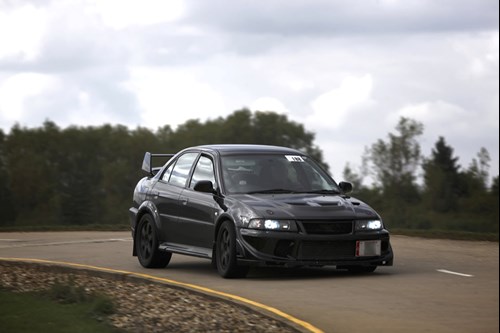
After the work on braking techniques, it’s time to head over to the high speed bowl. Featuring five lanes, with the outer lane being banked at an intimidating 35 degrees, here it’s possible to test out not only the top speed of your car but also get familiar with some of its characteristics.
We start off in the bottom lane; first up is a double lane change. Completed at 30mph, the aim is simply to transfer to the next lane and back again as quickly as possible. The first thing to notice is the effect it has on your speed. As the car - and passengers - move around, your foot increases and decreases pressure - by a small amount granted but this is just at a low speed. Now conscious of this variation when changing lane, Colin explains that you should tense your thigh muscle. The tension eliminates any variation in pressure and we’re soon able to change lanes without any change in speed. Now it’s time to quicken up the lane change. Constant practising soon had my wrists aching from the effort, but then came time to evaluate. Which is moving quicker - the front or the rear? Reading feedback from the car and putting it into words has never been my forté, but Colin is patient as always and my eventual answer pleasantly proved to be correct. He then goes on to explain that this is a good way of evaluating a car’s core handling characteristics. Done at such a slow speed, it’s unlikely to cause any major drama but will allow you to see if the car is prone to understeer, oversteer or feels reasonably balanced. We up the speed to 40mph, along with a caution that it will likely cause a spin, but the Evo outwits us both and switches lanes with only the merest hint of slip.
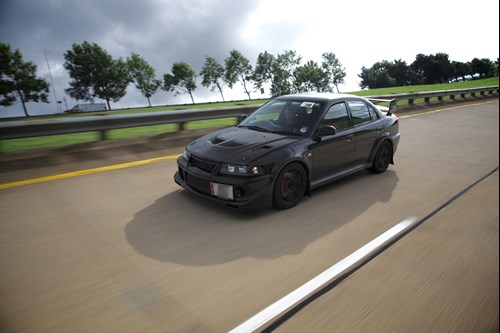
Dropping the speed back to 30mph, the next technique to practise is increasing the throttle in the second part of the lane change. As the weight rolls to the outside of the car in the turn, using extra throttle lifts the nose slightly and permits greater turn-in than a constant throttle. A quick try and lo and behold, the car tucks in beautifully. It’s a perfect example of a technique that would have been difficult to stumble upon as it runs counter to the classic 4WD understeer correction. A few more practices swiftly follow, but there’ll be the chance to put it into proper use later on the track in compound corners.
For now, it’s time to increase the speed and climb up the lanes to lane five. With a minimum speed of 100mph, this is not a place to hang around. On my previous trip, this lane was used to demonstrate how to control the car with the accelerator, by the rather terrifying act of removing both hands from the steering wheel entirely. If barrelling around a steeply banked circuit wasn’t enough, removing any contact you have with the steering wheel is unnerving to say the least. The first hand is easy; the second is completed finger by finger, with the last one lingering for an inordinate amount of time, before lifting to hover over the wheel. The car thankfully continues round the circuit at around 100mph and as I come to terms with the fact that we’re not going to die horribly, both hands are eventually placed on the roof lining. The only control over the car now is through the accelerator. Press the pedal and it moves up the bank, come off it and it moves down. It’s entirely possible to steer the car in this way. It’s a very surreal experience though!
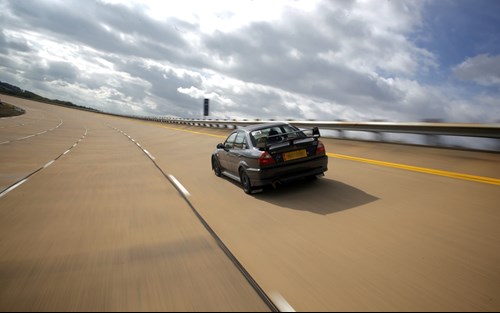
This time round, the idea is to look out for a few steering characteristics of the car. The first is compliance steer. This is a characteristic built into the majority of cars which means that the car will tend to track in a straight line. The imperfections and bumps in the road cause the suspension components to move, occasionally moving the car in one direction or another, but as a whole, they will work together to bring the car back onto the original path. As a driver, the object of this lesson is to note that you don’t need to work unnecessarily to try and combat this. Any adjustments will only mean further adjustments down the line and as always, the aim is to try and minimise any inputs to the steering.
Many people tend to grip the wheel tighter at higher speeds, yet it’s not necessary and will only cause undue strain. With a light grip and relaxing of the shoulders, you can feel the car moving around underneath you - sometimes an inch or two to the left, sometimes to the right, but it always comes back to the same lane with minimal intervention.
Next up is bump steer: where the act of the wheel moving up and down over bumps can cause a steering effect. This is due to the suspension component set-up - it can be an issue with heavily lowered cars - but is luckily something that my car suffers little from. Colin informs me that Lotus owners are not so lucky, but the Evo does me proud.
Handling circuit
Coming off the high speed bowl, there’s one part of the day left: putting everything I’ve learnt into practice. The handling circuit is a small track featuring minor elevation changes, cambered sections and a variety of corners, including double apexes, compound corners and long sweepers. The surface is two lanes wide, lined by a strip of gravel and marked by bollards. Although you want to get faster, you don’t want to go too wrong here! Things start off slow enough, taking a few sighting laps to check out the corners, mark turn-in points, camber and corner severity. Once the track is clear in my mind, it’s then time to start upping the speed. One thing is critical on circuit - to look far ahead. Colin insists that you’ll go where you look, so all attention is focused on what’s to come. It brings a range of benefits, from allowing you to judge turn-in points better, to allowing to pick the right point to start feeding the throttle back in after the apex.

As I drive the course, the techniques I’ve learnt throughout the day all come into play. Threshold braking is required to scrub off speed before corners, and through each turn, it becomes addictive to try and hit the perfect single input steering angle. The compound corners are tackled by applying more throttle and all the time, looking further ahead and being fast on the controls can be practised. Round and round we go, the speed gradually increasing. It’s a huge confidence boost to have Colin sitting beside you, reassuring you that actually, yes, you can take that corner just a touch faster. With the short length of the track, you soon get to try it out for yourself, and let’s just say, he’s yet to be wrong. Soon the tyres are letting out tortured squeals as they scrabble for grip and the car tiptoes ever closer to the edge of the track. Before long, Colin confirms that the corner just gone was perfect and could not be taken any faster. It’s a real sense of accomplishment.
Soon, Colin pointed out the Evo was running close to empty and we called it a day. It was only after slowing down that it begin to dawn on me how demanding the driving was - it requires your utmost concentration and with your arms and legs poised for action, is taxing, yet exhilarating. It makes it all the more impressive that some drivers do this for six hour stints!

After heading back to the CAT DT HQ and having a re-cap of the day’s lessons, it’s soon clear just how much I’ve picked up in one day. The techniques will no doubt prove invaluable, but equally as important was the clear and patient manner in which they are always explained. Questions are welcomed and Colin has a way of being able to explain even complicated principles in a manner that suits the individual. This relaxed approach leaves you feeling at ease and able not just to absorb information, but also to thoroughly enjoy yourself as well. My head was whirring with the new lessons we’d covered, but a quick re-cap really helped to cement the day’s work and also to answer any remaining questions. By the end of it, there was only question running around my brain though: when can I next get on track to try it all out?!

Thanks to Colin and Jo for the fantastic day. At the risk of sounding like Arnie - I’ll be back.
Suzy Wallace
Pictures with thanks to Jonathan Moore
Call: 01234 757 633
Email: info@catdrivertraining.co.uk
CAT Driver Training is the fast way to develop & improve authentic dynamic driving skill, technique & knowledge from the Best. OEM recognised driver training for individuals & the motor industry. As the leading UK based independent advanced performance driving skills company, we exist to make your driving experience even better. Explore your cars potential, fulfill your own. Coaching advanced road & track skills, safety driver training courses for individual driving enthusiasts & advanced driving for all facets of the motor industry. The only training company resident within UTAC's Millbrook Proving Ground in Bedfordshire, within easy reach of London, & all surrounding counties: Hertfordshire; Buckinghamshire; Oxfordshire; Nottinghamshire; Cambridgeshire; Norfolk; Suffolk; Essex; & Surrey. Clients travel from the World over & the UK to learn from the authentic evidence based dynamic driving & vehicle dynamic experts. | All Rights Reserved | Copyright 2005 – 2024
Some of the links we use are affiliate links. This means that, at no cost to you, CAT will earn an affiliate commission if you click through the link and finalise a purchase.
Designed by WHP
Coded and built by Prominent Media